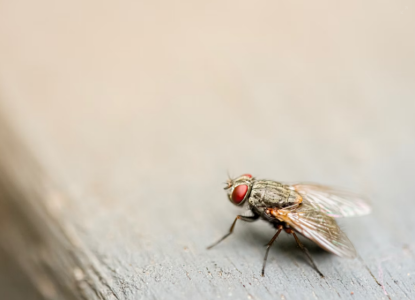Why the US is preparing to release millions of sterile flies over southern borders
- Replies 0
It might sound like something out of a bizarre science experiment, but a strange new tactic is taking flight in parts of the US It involves aircraft, insects, and a very specific target.
But not the one you might assume. While the idea may trigger discomfort or confusion, its purpose is precise and calculated.
And despite how it sounds, this operation could become one of the most important public health defenses in years.
A growing threat has reappeared in the form of a parasitic insect that targets living tissue and spreads quickly through warm regions.
The New World screwworm, a metallic blue blowfly with flesh-eating larvae, has returned after decades of being eradicated from the US “After 12 to 24 hours, those eggs all hatch, and they immediately start burrowing and feeding on the tissue of that animal,” said Dr. Phillip Kaufman of Texas A&M University.
Unlike common flies, screwworms lay eggs in open wounds, and the resulting larvae can kill livestock or wildlife within one to two weeks if left untreated.

The pest had been absent from Central America for over 20 years, but new cases began emerging again in early 2023.
Infections have since spread across Panama, Costa Rica, Nicaragua, Honduras, and into southern Mexico.
That escalation forced several US livestock trading ports to close and sent agricultural officials scrambling to contain the threat. “We know the incredible economic impact an infestation would cause,” said Texas rancher Stephen Diebel.
The US is now relying on a decades-old but highly effective method to fight back against the advancing screwworm population.
Also read: This natural trick keeps mosquitoes away—and it's a game-changer for outdoor nights
Instead of using chemicals, scientists are releasing sterilized male flies into the environment to disrupt breeding.
“The result: impotent adult flies that cause female mates to lay unfertilized eggs,” explained the USDA. Since females only mate once in their lifetime, introducing enough sterile males leads to population collapse over time.
These flies are bred in specialized labs where their pupae are exposed to gamma radiation to prevent successful reproduction. Once sterilized, the adult males are packed into temperature-controlled containers and dropped over rural areas.
“There’s no need to panic... the flies have no interest in urban environments,” said Kaufman, addressing public concerns. The technique only affects screwworms and has no known impact on other species or ecosystems.
To meet the rising need, US authorities are scaling up production dramatically in anticipation of wider outbreaks.
In June, the USDA announced it would build a new sterile fly dispersal facility at Moore Air Base in Hidalgo County, Texas. The dispersal site alone is projected to cost $8.5 million, while a full production facility is estimated at $300 million.
“Having (a domestic production facility) here is super important … to control the distribution of those sterile flies more efficiently,” said Diebel. An additional $21 million will go toward renovating a retired fly factory in Mexico, with a target to increase capacity by late 2025.
These facilities will work together to release hundreds of millions of sterile flies weekly across critical livestock corridors.
Also read: Brace yourself: Alien-like insect set to invade 13 states after 17 Years!
With these efforts underway, several livestock ports in Texas, Arizona, and New Mexico have begun reopening after being closed due to contamination fears. Surveillance teams continue to monitor new cases and adjust flight operations accordingly.
Without effective vaccines or repellents for screwworms, the livestock industry depends on daily wound inspections and early detection to prevent spread. The parasite also threatens wildlife, including deer, birds, and rodents, making it even more difficult to control once established.
“It’s a daily chore to provide those inspections to our livestock, just to make sure they’re not infested,” Diebel explained. The USDA urges ranchers to avoid procedures like tagging or branding during warmer months, when screwworms are most active.
This plan may sound unusual, but it is grounded in decades of research and prior success. The US once eradicated screwworms using this exact strategy—and officials are hoping to replicate that victory before the pest crosses the border.
With outbreaks now creeping north and millions of animals at risk, time is running short. Still, if the program holds, it could be one of the most important—and unexpected—defensive measures in US agricultural history.
Read next: Swarming insects cause highway havoc as car flips—officials issue warning

What are your thoughts on this unusual yet science-driven approach? Would you support more insect-based programs if they protected food supplies or natural ecosystems? Have you ever encountered livestock threats in your community, or known someone who has? Drop your thoughts and questions in the comments—we want to hear from you.
But not the one you might assume. While the idea may trigger discomfort or confusion, its purpose is precise and calculated.
And despite how it sounds, this operation could become one of the most important public health defenses in years.
A growing threat has reappeared in the form of a parasitic insect that targets living tissue and spreads quickly through warm regions.
The New World screwworm, a metallic blue blowfly with flesh-eating larvae, has returned after decades of being eradicated from the US “After 12 to 24 hours, those eggs all hatch, and they immediately start burrowing and feeding on the tissue of that animal,” said Dr. Phillip Kaufman of Texas A&M University.
Unlike common flies, screwworms lay eggs in open wounds, and the resulting larvae can kill livestock or wildlife within one to two weeks if left untreated.

Why the US is preparing to release millions of sterile flies over southern borders. Image source: Jin Yeong Kim / Unsplash
The pest had been absent from Central America for over 20 years, but new cases began emerging again in early 2023.
Infections have since spread across Panama, Costa Rica, Nicaragua, Honduras, and into southern Mexico.
That escalation forced several US livestock trading ports to close and sent agricultural officials scrambling to contain the threat. “We know the incredible economic impact an infestation would cause,” said Texas rancher Stephen Diebel.
The US is now relying on a decades-old but highly effective method to fight back against the advancing screwworm population.
Also read: This natural trick keeps mosquitoes away—and it's a game-changer for outdoor nights
Instead of using chemicals, scientists are releasing sterilized male flies into the environment to disrupt breeding.
“The result: impotent adult flies that cause female mates to lay unfertilized eggs,” explained the USDA. Since females only mate once in their lifetime, introducing enough sterile males leads to population collapse over time.
These flies are bred in specialized labs where their pupae are exposed to gamma radiation to prevent successful reproduction. Once sterilized, the adult males are packed into temperature-controlled containers and dropped over rural areas.
“There’s no need to panic... the flies have no interest in urban environments,” said Kaufman, addressing public concerns. The technique only affects screwworms and has no known impact on other species or ecosystems.
To meet the rising need, US authorities are scaling up production dramatically in anticipation of wider outbreaks.
In June, the USDA announced it would build a new sterile fly dispersal facility at Moore Air Base in Hidalgo County, Texas. The dispersal site alone is projected to cost $8.5 million, while a full production facility is estimated at $300 million.
“Having (a domestic production facility) here is super important … to control the distribution of those sterile flies more efficiently,” said Diebel. An additional $21 million will go toward renovating a retired fly factory in Mexico, with a target to increase capacity by late 2025.
These facilities will work together to release hundreds of millions of sterile flies weekly across critical livestock corridors.
Also read: Brace yourself: Alien-like insect set to invade 13 states after 17 Years!
With these efforts underway, several livestock ports in Texas, Arizona, and New Mexico have begun reopening after being closed due to contamination fears. Surveillance teams continue to monitor new cases and adjust flight operations accordingly.
Without effective vaccines or repellents for screwworms, the livestock industry depends on daily wound inspections and early detection to prevent spread. The parasite also threatens wildlife, including deer, birds, and rodents, making it even more difficult to control once established.
“It’s a daily chore to provide those inspections to our livestock, just to make sure they’re not infested,” Diebel explained. The USDA urges ranchers to avoid procedures like tagging or branding during warmer months, when screwworms are most active.
This plan may sound unusual, but it is grounded in decades of research and prior success. The US once eradicated screwworms using this exact strategy—and officials are hoping to replicate that victory before the pest crosses the border.
With outbreaks now creeping north and millions of animals at risk, time is running short. Still, if the program holds, it could be one of the most important—and unexpected—defensive measures in US agricultural history.
Read next: Swarming insects cause highway havoc as car flips—officials issue warning
Key Takeaways
- The New World screwworm is a flesh-eating parasite that lays eggs in wounds, leading to fatal infections in cattle, wildlife, and even humans.
- The US is combating the spread using sterile insect technique—dropping gamma-irradiated, sterile male flies over rural areas to prevent breeding.
- A new $300 million fly production facility is planned for Texas, with a $21 million expansion of a Mexican site also underway.
- Without control, screwworm outbreaks could cost the livestock industry billions and threaten ecological stability across the region.






